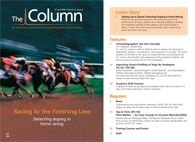Low-Pressure GC and UHPLC Analysis of Environmental Contaminants in Meats
A team of researchers has developed a high‑throughput analysis method for 192 diverse pesticides and 51 environmental contaminants in cattle, swine, and poultry meats. The team used a combination of low-pressure gas chromatography coupled to tandem mass spectrometry (LP)GC–MS–MS and ultrahigh-pressure liquid chromatography coupled to tandem MS in the analysis.
Photo Credit: Brasil2/Getty Images

A team of researchers has developed a highâthroughput analysis method for 192 diverse pesticides and 51 environmental contaminants in cattle, swine, and poultry meats.1 The team used a combination of low-pressure gas chromatography coupled to tandem mass spectrometry (LP)GC–MS–MS and ultrahigh-pressure liquid chromatography (UHPLC) coupled to tandem MS in the analysis.
Meat makes up a large proportion of most human diets with an average estimated consumption of 42–76 kg per person worldwide.2 It is an important nutritional source of proteins, essential amino acids, and bioavailable minerals and vitamins; however, at the same time the bioaccumulation of anthropogenic chemicals, particularly pesticides and environmental contaminants, can result in human exposure to potentially harmful substances.
“According to the US EPA,3 the main source of meat contamination by pesticides comes from their applications to crops. In the case of environmental contaminants, which are typically chemicals used in commerce and industrial applications, from their transport in the environment,” explained Yelena Sapozhnikova from the US Department of Agriculture.
Many pesticides have been shown to cause various health effects and for this reason maximum residue levels (MRLs) or tolerances have been established to control their levels in meat. Depending on toxicity, pesticide tolerances can range from 10 to 3000 ng/g.
“It depends on the contaminant’s toxicity and possible health effects, and they vary from one chemical to another. Studies show that most pesticides and environmental contaminants do not occur in meat samples at high concentrations capable of causing acute effects, but rather at very small quantities,” clarified Sapozhnikova.
Sample preparation was based on the QuEChERS approach using filter-vial dispersive solid-phase extraction (d-SPE) cleanup. The extracts were analyzed in parallel by (LP)GC–MS–MS and UHPLC–MS–MS (10 min each). The method was validated at three spiking levels (10 ng/g, 25 ng/g, and 100 ng/g) at or below established tolerance levels in the sample types. Acceptable recoveries (70–120%) and relative standard deviations (RSDs) ≤ 20% were achieved for 200 (82%) of the analytes.
“The good news is [that] when we analyzed meat samples in our study to test the new method, we found only four pesticides out of 243 contaminants we tested for. One of the measured compounds was a metabolite of DDT, a pesticide that has been banned decades ago, but because of its persistence, its metabolites are still detected in small quantities. And pesticide concentrations measured in meats were below their established tolerance levels,” added Sapozhnikova.
The method used within this study was built upon a method previously developed for fish and seafood.4,5 Modifying this method presented challenges - particularly because of the complexity of meat samples. Following an efficient clean-up process, Sapozhnikova and her fellow researchers encountered coâextracted matrix compounds which were interfering with the analysis among other problems. Eventually a methodology was developed that proved to be efficient and effective.
“The sample preparation is fast where one analyst can prepare a batch of 10-12 pre-homogenized samples in one hour, and the simultaneous analysis by both GC– and LC–MS–MS in parallel takes 10 minutes each. The cost is rather low as well, with $3/sample using bulk materials,” said Sapozhnikova.
The researchers responsible for this study are currently evaluating an automated instrument top sample preparation for high-throughput analysis of chemical contaminants. Furthermore, this current study is being expanded to include 100 additional pesticides recommended for testing by the US Environmental Protection Agency. - L.B. & K.M.
References
- L. Han, Y. Sapozhnikova, and S.J. Lehotay, Food Control 66, 270–282 (2016).
- Food Outlook. Biannual report on global food markets (2014). Available at: http://www.fao.org/3/a-i4136e.pdf
- United States Environmental Protection Agency (US EPA). Environments and Contaminants. Chemicals in Food. Available at: https://www.epa.gov/sites/production/files/2015-05/documents/environments-contaminants-chemicals-food.pdf
- Y. Sapozhnikova and S.J. Lehotay. Anal. Chim. Acta 758(0), 80–92 (2013).
- Y. Sapozhnikova, J. Agric. Food Chem. 62(17), 3684–3689 (2014).

Determining Enhanced Sensitivity to Odors due to Anxiety-Associated Chemosignals with GC
May 8th 2025Based on their hypothesis that smelling anxiety chemosignals can, like visual anxiety induction, lead to an increase in odor sensitivity, a joint study between the University of Erlangen-Nuremberg (Erlangen, Germany) and the Fraunhofer Institute for Process Engineering and Packaging (Freising, Germany) combined behavioral experiments, odor profile analysis by a trained panel, and instrumental analysis of odorants (gas chromatography-olfactometry) and volatiles (gas chromatography-mass spectrometry).
Investigating 3D-Printable Stationary Phases in Liquid Chromatography
May 7th 20253D printing technology has potential in chromatography, but a major challenge is developing materials with both high porosity and robust mechanical properties. Recently, scientists compared the separation performances of eight different 3D printable stationary phases.
Detecting Hyper-Fast Chromatographic Peaks Using Ion Mobility Spectrometry
May 6th 2025Ion mobility spectrometers can detect trace compounds quickly, though they can face various issues with detecting certain peaks. University of Hannover scientists created a new system for resolving hyper-fast gas chromatography (GC) peaks.

.png&w=3840&q=75)

.png&w=3840&q=75)



.png&w=3840&q=75)



.png&w=3840&q=75)










